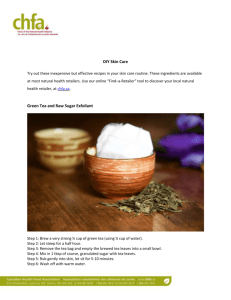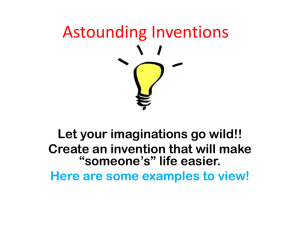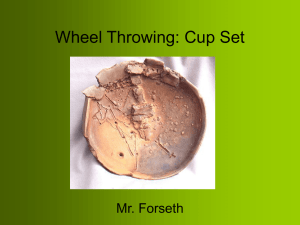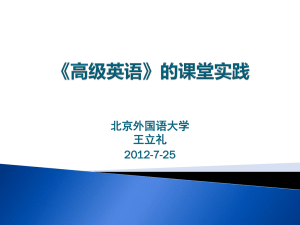Speeding Up Interactions
advertisement
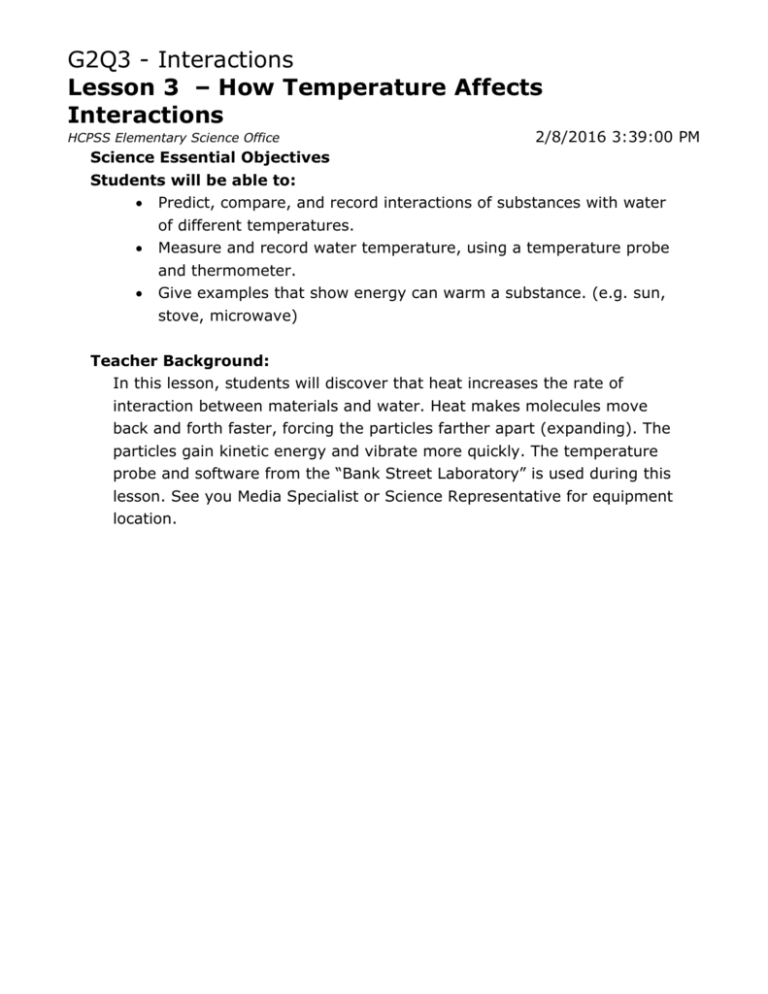
G2Q3 - Interactions Lesson 3 – How Temperature Affects Interactions HCPSS Elementary Science Office 2/8/2016 3:39:00 PM Science Essential Objectives Students will be able to: Predict, compare, and record interactions of substances with water of different temperatures. Measure and record water temperature, using a temperature probe and thermometer. Give examples that show energy can warm a substance. (e.g. sun, stove, microwave) Teacher Background: In this lesson, students will discover that heat increases the rate of interaction between materials and water. Heat makes molecules move back and forth faster, forcing the particles farther apart (expanding). The particles gain kinetic energy and vibrate more quickly. The temperature probe and software from the “Bank Street Laboratory” is used during this lesson. See you Media Specialist or Science Representative for equipment location. G2Q3 - Interactions Lesson 3 – How Temperature Affects Interactions 8/2/2012 6:51:00 PM HCPSS Elementary Science Office Teacher Preparation: Locate, set up, and practice using the temperature probe and software. Prepare a tray for each group of two students with two tea bags, two sugar cubes, a 10 oz. cup of warm water, (not steaming – from the faucet), a 10 oz. cup of cold water (from a really cold water fountain or refrigerator), and a spoon. Group students in pairs. Have a thermometer available for each pair of students for the engagement and exploration. Materials Needed For: Provided in the KIT: Consumables To be ordered from Science Located in your SCHOOL Resource Center Teacher Two packets of hot cocoa Food coloring Four 10 oz. cups “The Bank Street Laboratory” Microcomputer -Based Laboratory (see media specialist) Computer with monitor Thermometer Warm water from the tap Cold water from a cold water fountain or refrigerator Group of 4 or 5 Students Pair of Students Two sugar cubes Two tea bags One 10 oz. cup of warm water One 10 oz. Thermometer Pencils Goggles cup of cold water Individual Students Spoon Hot and Cold by Karen Bryant-Mole Crayons G2Q3 - Interactions Lesson 3 – How Temperature Affects Interactions HCPSS Elementary Science Office 8/2/2012 6:51:00 PM Engagement: 1. Distribute Hot and Cold by Karen Bryant-Mole. Guide students to share the purpose for reading (to be informed about temperature). Chart students’ ideas about how substances become hot or cold. 2. Read aloud to students or invite students to partner read pages 4 – 11. 3. Invite each pair to Think-Pair-Share (TPS) one fact that they learned. 4. Model for students how to read a thermometer. 5. Display two cups of cold water. Invite students to assist in measuring the temperature in the two cups. 6. Empty the contents of the hot cocoa packet into one cup and stir. 7. Have students discuss their observations (chocolate powder does not mix with cold water, lumpy). 8. Put six drops of food coloring into the second cold water cup slowly and have students share their observations. 9. Have students predict what would happen if the hot cocoa packet and food coloring were placed in warm water. 10. Revisit the iced tea problem from Lesson 1. Ask students to think about having to make large quantities of tea and whether they would rather make the tea quickly or slowly. Have students explain why making tea quickly would be beneficial. 11. Have students Think-Pair-Share (TPS) to predict if warm or cold water will make tea faster. Exploration: 1. Distribute Student Response Booklets and have students open to SRB p. 4, “Speeding Up Interactions.” 2. Use a guided reading strategy or choral reading to engage students in reading the directions. 3. Ask students to describe the investigation in their own words, using references to the directions and illustrations on the students response sheet. 4. Demonstrate the use of temperature probe with students and set up equipment to measure the temperatures in the cups of warm and cold water. 5. Tell students they will measure the temperature in their cups with thermometers and later compare findings to the class cups of warm and cold water. 6. Distribute materials to pairs of students. 7. Direct students to work with their partners to complete the investigation and record their data on SRB p. 4. 8. Circulate to assist students and ask the following questions, allowing wait time: What do you observe as the tea bag is dunked into the warm water and cold water? Compare your observations of warm and cold water. Observe the water cups. Which cup created tea faster? Explain why you believe this happened. Observe the water cups. In which cup did the sugar dissolve faster? Explanation: 1. Ask students to bring their Student Response Booklets to the discussion area. 2. Share results of the temperature probe readings and have students compare these results with their thermometer readings. 3. Discuss their findings by asking the following questions, using TPS strategy: If you need to make large quantities of tea quickly, would you use warm or cold water? Explain why you chose warm or cold water. In what other situation may you need to use warm water to speed up an interaction in real life? (making gelatin, making pudding, making au gratin potatoes, washing sticky dishes, or oily hands) Now that we have completed the investigation, do you think there will be a difference if we put the hot chocolate powder and food coloring in warm water? 4. Empty the cocoa packet into the warm water and invite students to share their observation and compare their ideas with the cold cup from the engagement. 5. Have students partner read pages 22-23 of Hot and Cold by Karen Bryant-Mole*. Discuss other ways heat can cause an interaction. 6. After this discussion, elicit from students what they have learned about asking tea and record their ideas under the “Learned” section of the class chart. 7. Discuss whether or not any “Need-to-Know” questions were answered, and, if so, record findings under the “Learned” section of the chart. 8. Discuss whether of not any additional questions have been raised about making iced tea. Record any new questions under the “Need-to-Know” section of the chart. Extension – Day 2 1. Invite students to the discussion area and review what they learned from lesson three using the “Learned” column of the “Know-Need to KnowLearned” chart. Re-read the unit problem from the chart paper and display a pitcher of room temperature water. Use TPS to discuss the following: How can you make the tea quickly? (use warm water) Where could we get warm water safely? (from the tap) Use a guided reading strategy to read the writing prompt on SRB p. 5, “Temperature and Interactions,” and model how to make a list. Tell students they must use all the words in the word box in their response. 2. (Optional) Have students read to perform a task by reading the directions to make gelatin. Discuss the purposes of the warm and cold water. 3. (Optional) Have students investigate the interaction of other liquids and materials, such as juice, syrup, oil, cocoa, etc… with water. 4. (Optional Language Arts Connection) Obtain a copy of Freckle Juice ** by Judy Blume. Have student read Freckle Juice and describe the interactions and results of interactions in the story. Evaluation: 1. SRB p. 4, “Speeding Up Interactions” (Answer Key on right side tab) 2. SRB p. 5, “Temperature and Interactions” (Answer Key on right side tab) 3. Students’ oral responses *Bryant-Mole, Karen. Hot and Cold. Des Plaines: Heinemann, 1998. **Blume, Judy. Freckle Juice. New York: Simon & Schuster, 1984. G2Q3 - Interactions Lesson 3 – How Temperature Affects Interactions HCPSS Elementary Science Office Speeding Up Interactions Part 1 Directions: 1. Measure and record the temperature of the water in Cup A and Cup B. 2. Dunk a tea bag 50 times in each cup. 3. Draw what you see and write your observations on the lines. • darker • tea made faster • lighter • takes longer Part 2 Directions: 1. Measure and record the temperatures of the tea in Cup A and Cup B. 2. Stir a sugar cube 50 times in each cup 3. Draw what you see and write your observations on the lines. • disappears • dissolves • some of the cube is left • dissolves slower G2Q3 - Interactions Lesson 3 – How Temperature Affects Interactions HCPSS Elementary Science Office Temperature and Interactions The day before your booth opens, you decide to make the tea. List the steps you would follow to make the tea. Then describe what you have learned about how temperature can affect an interaction. Use evidence from your investigation to support your procedures. The steps I would follow to make the tea are: Answers will vary but should include * A reference to the benefits of using warm water to speed an interaction * A summary of investigation results to support ideas * A logical sequence of steps (get warm water from tap, put tea bags in water, add sugar, stir to dissolve sugar) I learned that warm temperatures can speed an interaction. I know this because in my investigation, the tea and sugar dissolved faster in warm water than in cold water.
